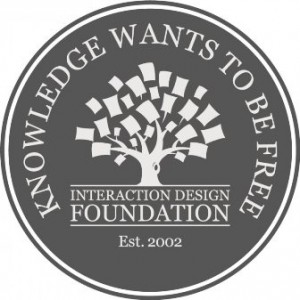I have been actively engaged the past month and taking my self-study efforts from a new organization, Interaction Design Foundation. At the present time I am participating in two classes, Design Thinking and The Psychology of Online Sales. I have been enjoying and learning from both. I encourage you to read the press release from the organization and browse the website.
Non-Profit Gives Designers Free Educational Materials: If you feel like a dunce whenever you try to decipher the instructions to a new microwave, format a paragraph in the latest version of Word, or coax a wireless printer into talking to a computer, Mads Soegaard has a message for you: “It’s not your fault.? It’s the technology that’s dumb, not you.” The 37-year-old former IT worker is so convinced that better tech design will improve everyone’s quality of life that he and his wife Rikke sold their car, mortgaged their home and lived on a semi-deserted island for a time in order to re-launch www.interaction-design.org — a nonprofit organization dedicated to distributing educational materials to industry, academia and individuals across the globe — free of charge. 
Interaction-Design.org wants to democratize knowledge by distributing free materials produced by the world’s leading technology designers, professors, futurists and bestselling authors.? Two contributing authors are Clayton Christensen, the Harvard professor praised as “brilliant” by New York Mayor Michael R. Bloomberg, as well as Steve Mann, known as the father of wearable computing and the inspiration for Google’s high-profile “Project Glass.” Unlike nonprofits such as the Khan Academy, however, Interaction-Design.org also aims to democratize the usability of technology through improved product designs.
“We’re leading a battle against frustrating and time-consuming technology — poor designs that drain our productivity, our dignity and sometimes our sanity,” says Soegaard.? “Too many PCs, mobile devices, household appliances and software applications are designed with engineers in mind, not consumers.? In fact, study after study shows that computers are the leading cause of lost productivity.? One survey revealed that crashes, printer jams and network problems cost the average UK employee 48 minutes per day.? That’s one reason why we’re reaching out to the next generation of tech designers with free, world-class educational materials.”
Interaction-Design.org currently distributes (and constantly updates) The Encyclopedia of Human-Computer Interaction, a magnum opus featuring 30 chapters on topics ranging from “User Experience and Experience Design” to “Wearable Computing,” “Visual Aesthetics” and “Semiotics.”
Since its founding in 2002, the organization has helped to modernize the publishing industry by:
About The Interaction Design Foundation: Headquartered in Arhus, Denmark, the primary goals of Interaction-Design.org are to:
- Create and publish free and open educational materials for industry, academia and individual technology designers — materials written and produced by leading designers, professors, futurists and bestselling authors from around the globe.
- Enhance the design, function and usability of technology by helping to educate the next generation of user interface designers, user experience managers and product designers.
Says Interaction-Design.org founder Mads Soegaard: “Every day, I hear people say, ‘I’m not tech-savvy. ?I should take a course to learn this. ?I must not have read the manual properly.’ ?People should know that their frustrations with technology are not symptoms of their own intellectual inadequacy, but symptoms of badly designed technology.? Technology shouldn’t need a manual. ?If you need to include a manual, you haven’t designed the product properly.? One of our goals is to create a more people-oriented generation of designers and programmers.? We want them to reimagine high-tech products that are intuitive and easy to use.”
Through multimedia materials such as The Encyclopedia of Human-Computer Interaction, the organization’s authors, editorial team and advisory board are working to create a publishing venue tailored to authors and readers instead of profits. Already, Interaction-Design.org’s free online approach to publishing has helped authors reach 20,000% more readers than their previous records, which is quite an achievement when you consider that only best-selling technology and design authors have submitted materials.
For more information, contact Mads Soegaard at mads@interaction-design.org or visit www.Interaction-Design.org.
